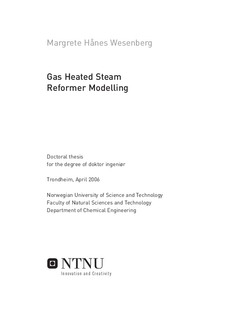| dc.contributor.author | Wesenberg, Margrete Hånes | nb_NO |
| dc.date.accessioned | 2014-12-19T13:22:46Z | |
| dc.date.available | 2014-12-19T13:22:46Z | |
| dc.date.created | 2007-03-05 | nb_NO |
| dc.date.issued | 2006 | nb_NO |
| dc.identifier | 122646 | nb_NO |
| dc.identifier.isbn | 82-471-7904-0 | nb_NO |
| dc.identifier.uri | http://hdl.handle.net/11250/248060 | |
| dc.description.abstract | Conversion of natural gas is becoming increasingly relevant in the future as the world energy market will demand cleaner fuels, cleaner production of fuels and better utilization of the large, remote, and still undiscovered gas reserves in the world. The refining of the natural gas to synthetic gasoline, diesel and future energy fuels such as methanol and hydrogen is a solution for making the most of these gas reserves.
The intermediate process step in gas refining, the synthesis gas production from natural gas, represents 60–80 % of the total investment cost of a methanol or synthetic fuels plant. This drives the technological development within this process field towards improvements for increasing the efficiency and reducing the costs. The synthetic gas production by steam reforming is a widely used, expensive and energy demanding technology. Steam reformers demand large base areas and are heated by natural gas combustion. Technological developments over the past two decades have lead to an alternative steam reformer, the gas heated reformer, which is a compact unit heated by flue gas or by further converted and heated synthesis gas.
This doctoral thesis is treating the gas heated steam reformer (GHR). The motivation was to develop a complete mathematical model combining of the reactor side and the hot gas side of the reformer and furthermore to investigate the best mathematical descriptions of the heat transport mechanisms involved. The complete model should be as simple as possible but nevertheless be on a level where the important heat transport mechanisms are adequately modelled.
The resulting model is a two-dimensional, finite difference model of a packed bed catalytic tube enclosed by an annular section for counter current flow of the heating gas. The separate partial models, the reactor model and the annulus model, are connected by iterative solution with direct substitution of the temperature and heat flux profiles of the outer reactor tube wall.
The reactor model comes in two versions: a heterogeneous model and a pseudohomogeneous model. The species transport is described by radial dispersion, axial convection and chemical reaction. The heat transport is modelled with terms for radial conduction, axial convection and the heat sink related to the net endothermic reactions.
The annulus model is a simplified plug flow model disregarding the turbulence present. The effect of the turbulent flow on the radial heat transport is still included, by using an effective radial thermal conductivity in the temperature equation. The values for the effective radial thermal conductivities are provided by external simulations in computational fluid dynamics (CFD), where turbulence is modelled by the k-ε turbulence model. The radial heat transport by gas radiation is included by solving the radiative intensity equations by the discrete ordinates method.
The method of importing data for the effective radial thermal conductivity calculated with CFD was evaluated by running test simulations comparable to the CFD simulations. The results showed almost identical axial and radial temperature profiles in the two models when all dissimilarities in the models were allowed for. This simplifying method was thus approved adequate for the purpose.
It was also found that the inclusion of the radial profile of the effective radial thermal conductivity was significant for the overall GHR simulations. Using a mean value for the effective radial thermal conductivity did not result in temperature profiles similar to the profiles of the CFD simulations where turbulence was modelled.
The restrictions related to the mass and heat transport between the gas bulk and the porous pellets were investigated. These resistances are usually neglected in heterogeneous steam reformer modelling based on assumptions that they do not affect the overall reactor simulation results. The heterogeneous reactor model of this thesis includes all pellet transport resistances. Estimations showed that the reaction effectiveness factors, which are defined relative to the pellet surface conditions, were greater than the alternative effectiveness factors defined relative to the bulk conditions. This implies that there exist transport limitations between the two phases. These transport restrictions were found to be of importance when evaluating local effects, as reaction kinetics in general and approach to equilibrium for the coke reactions responsible for catalyst deactivation. On the other hand, the overall reactor simulations were hardly influenced by the interphase transport limitations. This was seen from comparative simulations of the pseudo-homogeneous model using the effectiveness factors and the alternative effectiveness factors. These simulation results were almost equal, while the latter was identical to the results of the heterogeneous model accounting for the resistances. | nb_NO |
| dc.language | eng | nb_NO |
| dc.publisher | Fakultet for naturvitenskap og teknologi | nb_NO |
| dc.relation.ispartofseries | Doktoravhandlinger ved NTNU, 1503-8181; 2006:77 | nb_NO |
| dc.relation.haspart | Wesenberg, Margrete Hånes; Svendsen, Hallvard F. Mass and heat transfer limitations in a heterogeneous model of a gas heated steam reformer. Industrial and Engineering Chemistry Research. 46(3): 667-676, 2007. | nb_NO |
| dc.title | Gas Heated Steam Reformer Modelling | nb_NO |
| dc.type | Doctoral thesis | nb_NO |
| dc.contributor.department | Norges teknisk-naturvitenskapelige universitet, Fakultet for naturvitenskap og teknologi, Institutt for kjemisk prosessteknologi | nb_NO |
| dc.description.degree | dr.ing. | nb_NO |
| dc.description.degree | dr.ing. | en_GB |
